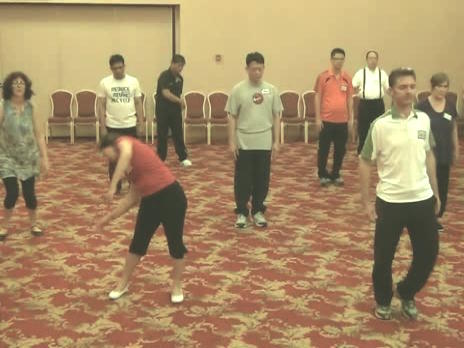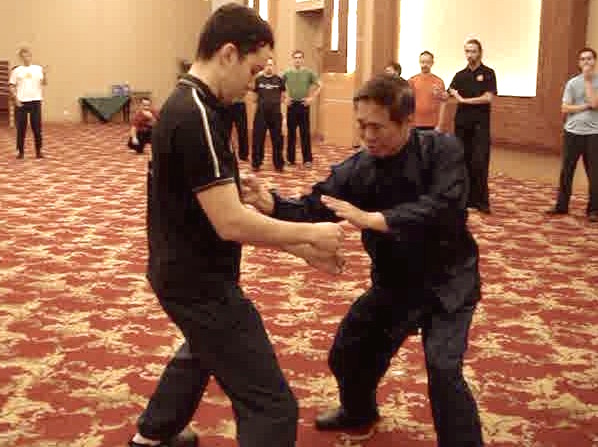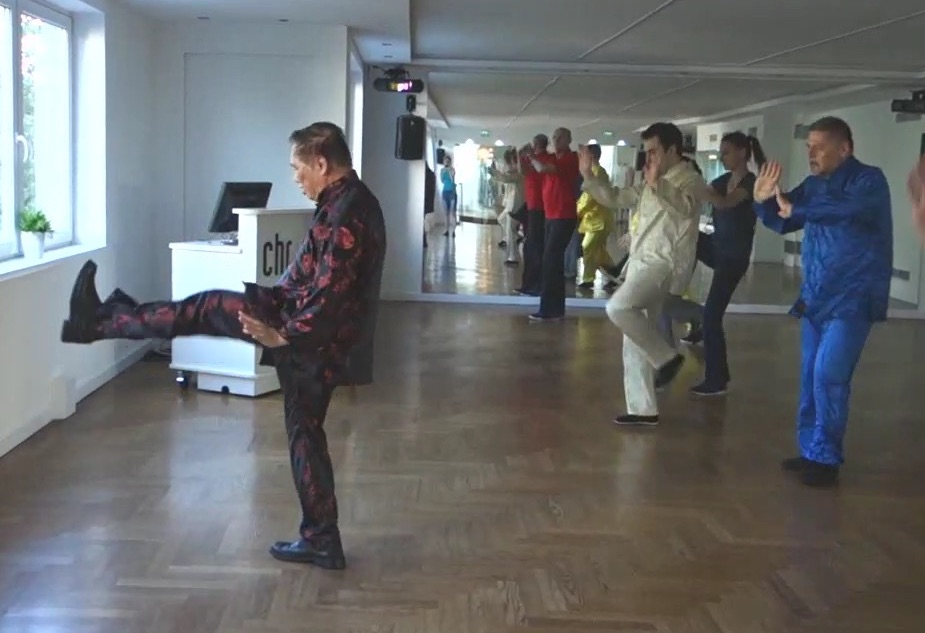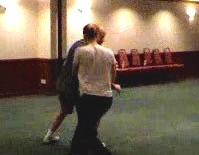SELECTION OF QUESTIONS AND ANSWERS
SEPTEMBER 2018 PART 3

It is chi flow, not the techniques, that gives chi kung benefits
Question 1
Sifu, you mentioned that our typical student in Shaolin Wahnam could attain in one month what a master would take one year. Why are our students so fast in their attainment?
— Ali, United Kingdom.
Answer
Although this is true, many people may not believe it. Let us take an example each from chi kung and from kungfu, the two arts taught in our school, Shaolin Wahnam.
Students who attended my regional or intensive courses could generate a chi flow, or energy flow, on the very first day they attended my courses. Students who attended regular classes from our qualified teachers might take a longer time, but at the most they could generate a chi flow within one month. This was for the students' sake so that they had more time to develop the skills of generating a chi flow, whereas students who attended my regional or intensive course had a much shorter time.
On the other hand, if a master could generate a chi flow in one year, it would be considered good result. I myself took 17 years before I could generate a chi flow.
What is so great about chi flow? It is chi flow, not the techniques, that gives chi kung benefits like good health, vitality, longevity, peak performance and spiritual joys. If a practitioner does not have chi flow, no matter how long he has practiced, he will not get any of the chi kung beneifts.
Let us now look at kungfu. The two pillars of kungfu training is internal force and combat efficiency. All those who attended my regional or intensive kungfu courses which lasted for about three days or five days could develop internal force and have combat efficiency after the courses. Those who attended regular kungfu classes could have internal force after a month, and combat efficiency using kungfu in three months.
Most other kungfu practitioners do not have internal force nor are able to use kungfu for combat irrespective of how long they have trained. For those who are very lucky, if they can develop internal force after one year, or can use kungfu for combat after three years, it will be good result.
Our students can have internal force and combat efficiency so fast because we differentiate between techniques and skills, know the philosophy of internal force training and combat efficiency, have the right methods, and I transfer the skills to them from heart to heart.
Most practitioners do not differentiate between techniques and skills. They believe, wrongly, that if they have the right techniques, they will develop internal force and be combat efficient if they practice consistently for some time, like a few years. The kungfu techniques of other students are correct, but most of them have no internal force and cannot apply their kungfu for combat, because they do not have the required skills.
The very lucky few who eventually develop internal force and are able to use kungfu for combat, acquire the necessary skills without their conscious knowing after many years of dedicated practice. Although they practice every day, their development of internal force and application of their kungfu for combat are haphazard.
We understand the philosophy and have the right methods of internal force training and combat application. More importantly, we transmit the necessary skills to our students from heart to heart, so that they can start their internal force training and combat application immediately, without the need to first acquire the skills. Their subsequent training is to improve their skills, instead of first acquiring them.
Question 2
Can you please tell us more about heart-to-heart transmission?
Answer
Many people are puzzled by heart-to-heart transmission. The highest Shaolin arts, for example, are transmitted from masters to students. It is the transmission of skills from the heart of a master to the heart of a student. It is not just instructions, or even teaching.
There are three levels of heart-to-heart transmission, namely physical, energy and mind.
At the physical level, a master ensures that his teachings are followed by students. He does not merely give instructions, but makes sure that his students follow them. For example, in a chi kung class, when I ask students to relax, I make sure they are relaxed. If any student is not relaxed, I shall go over to him and give him appropriate advice. In a kungfu class, if a student fails to follow my teaching when I tell students to lean on and not block an attack, I may demonstrate to him or physically move his arm to show him.
At the energy level, if a student fails to receive the teaching at the physical level, the master uses his own energy to lead the student's energy appropriately. For example, in a chi kung class of Pushing Mountain, if a student fails to generate an energy flow from his body to his palms. I may use my own energy to lead the flow in the student's arms. In a kungfu class, if I ask students to sink their chi to their dan tian, and a student fails to do so despite trying, I may use my chi to gently lead his chi to his dan tian.
At the mind level, the master uses his mind to activate the necessary skills in his students. I sometimes used this method on women in chi kung healing sessions. Instead of using my fingers to open energy points on sensitive spots of women, I used my mind to do so. In a kungfu class, if a student fails to explode force, I may use my mind to help him.

Wing Choon Kungfu from Sifu Choe Hoong Choy
Question 3
Suppose you could ask each of your four sifus a question each. What four question you would ask?
— Dimitri, Austria
Answer
Except for my first sifu whom I believe I was led to by divine guidance, I spent time to search for all my sifus, who were all the best in their arts.
My first sifu was Sifu Lai Chin Wah, more widely known as Uncle Righteousness. My second sifu was Sifu Chee Kim Thong, known as a living treasure of the Peoples' Republic of China.
My third sifu was Sifu Ho Fatt Nam, the third-generation-successor from the Shaolin Monastery at Quanzhou in Fujian Province of South China. My fourth sifu was Sifu Choe Hoong Choy, the patriarch of Choe Family Wing Choon Kungfu.
Uncle Righteousness was famous for his combat efficiency, and was well known to be righteous at a time when the fist instead of law ruled the day. I would ask him, "Sifu, how could I be efficient in combat?"
Sifu Chee Kim Thong was famous for internal force. I would ask him the secrets of internal force training.
Besides being very combat efficient and an expert in tramatology, or kungfu medicine, my third sifu, Sifu Ho Fatt Nam, was a spiritualist. I am proud and happy to have lived up to his teaching of always having a crystal clear consciousness. I would ask him to teach me about spirituality.
My fourth sifu, Sifu Choe Hoong Choy, was excellent in Wing Choon Kungfu. I would ask him what were the secrets that made Wing Choon Kungfu so special.
Question 4
I know about our philosophy that left-handers will benefit a lot from the dominant right-handed practice in our sets. But what about single-handed weapon training? Should the left-handers still use their weaker hand or should we mirror the sets?
— Sifu Leonard Lackinger, Shaolin Wahnam Austria
Answer
The philosophy that left-handed practitioners will benefit a lot from the dominant right-handed practice in our sets, applies to unarmed sets. Your question about single-handed weapon starts me thinking.
I believe that it is better for practitioners to use their better hand to hold the single weapon. Hence, left-handers should hold their weapons with their left hands. You should mirror the sets.

A tyoical kick from Shaolin Wahnam
Question 5
Two of my good friends approached me independently and asked me to teach them kungfu. I took the opportunity to practice my own teaching skills. These two persons were already skilled at training the form of some kung fu styles.
I drafted a lesson plan for different sections, each lesson being between 2 and 2.5 hours long, with each lesson covering a different aspect of fundamentals. I taught each one individually to avoid the issue of ego arising between the two.
— Frederick, USA
Answer
Teaching your two friends individually is a good start to train and develop your teaching skills. Later, you should teach a class, instead of teaching individually.
Students in your class should develop good kungfu culture, which includes overcoming their personal ego, and helping one another to progress. If any student is unable or unwilling to accept the kungfu culture you teach, you should ask him to leave. He is undeserving to be your student. We do not just teach kungfu; we teach students to enrich their lives and the lives of others.
Editorial Note: Frederick's other questions can be found at September 2018 Part 2 issue of the Question-Answer Series.
Question 6
Fundamentals: how to enter a qigong state of mind, the salient points of stances and developing internal force from zhan zhuang, basic footwork, body mechanics.
Hand Attacks: utilizing and defending against hand attacks.
Kicking: utilizing and defending against kicks.
Felling: break-fall safely and rolling, utilizing Black Bear Fells Tree and Fierce Tiger Pushes Mountains, and defending against throws and pushes by using Unicorn Stance, Double Butterfly Palms as well as General Receives Horse to reverse an attempt to fell an opponent.
Qin-na: applying a penetrating grip using the patterns "Single Tiger Claw" and "Old Eagle Catches Snake", and escaping from grips by remaining relaxed and using "Dark Dragon Enters Well".
Answer
You have over-taught, which is a common mistake of many new instructors. Give your two students some time to acquire these skills, not just learn the techniques. Most martial artists, including masters, may not differentiate between skills and techniques, but we do.

"Turning-body" to neutralize a felling attack
Question 7
A principle that came to mind while I was teaching was "to remove the leverage, turn the body." By removing the leverage and turning their body my students were able to escape my attempts to fell them or apply qin-na on them.
They were especially surprised and amazed at the idea of "General Receives Horse" to reverse attempts to throw them. One of them said it was "like magic."
The two students had been training kung fu from other schools but had no ability to apply their kung fu for sparring, and they confided in me that no one in their schools had internal force.
Answer
To many martial artists, our kungfu is like magic. Some may accuse us for lying or boasting, though we always speak the truth.
Our kungfu not only enables us to be combat efficient, but also contributes to our good health, vitality, longevity, peak performance and spiritual joys.
Hence, a poetic couplet we cherish in our school is as follows:
-
Marvelous techniques beget marvelous techniques
Wondrous Skills generate wonderousl skills
It is a norm today that most kungfu students cannot apply their kungfu for sparring, and they have no internal force.
Question 8
There were no injuries during the training, although one of them had some soreness in his arms after we did some arm-knocking so that he could feel the difference between me using muscular strength, me using flowing internal force, and me using consolidated internal force.
He told me that using flowing force "made my arm numb and it felt paralyzed for a few seconds," while using consolidated force simply bounced his arm out of the way in a very forceful manner.
Answer
Being injury free is the norm in genuine kungfu training, which is very rare today. Generously exchanging blows is not -- in genuine kungfu as well as in any martial arts. In genuine kungfu, we always assume that opponents can inflict serious injury with just one hit.
Because of your internal force, your student sustained soreness in his arms. Not many martial artists know the difference between flowing force and consolidated force. The terms "flowing force" and "consolidated force" were coined by me.
Your student's descriptions are both apt and interesting.
Question 9
Just to make sure that there would be no lingering injury, I applied the Cosmos Palm healing that you shared at the Cosmos Palm course, and I had him do "Lifting the Sky" with qi flow afterwards. I had a brief qi flow and "flicked" my hand to make sure that I didn't receive negative feedback from the injury.
I held my palm over his forearm and circulated the palm, used the thought that you said for healing, and it seemed as though my palm moved of its own accord, as though qi knew where to go. For that, I must thank you again for your excellent example in teaching as well as your autobiography on the art of teaching.
Answer
You did excellently. It is always good to take precaution that his arms could be damaged in arm knocking, as well as precaution for yourself by flicking your hands.
Qi knows where to flow. The injured parts of your student's arm are areas of low qi or low energy. Your palm is an area of high qi. Qi always flows from high levels to low levels.
If you have any questions, please e-mail them to Grandmaster Wong via his Secretary at secretary@shaolin.org stating your name, country and e-mail address.
LINKS
Selected Reading
- Shaolin Wahnam Policy on Challenges
- The Difference between Regional and Intensive Courses
- The Wonderful Benefits of the Shaolin Five-Animal Set
- Shaolin 36 Leg Techniques
- South to Old Smoky
